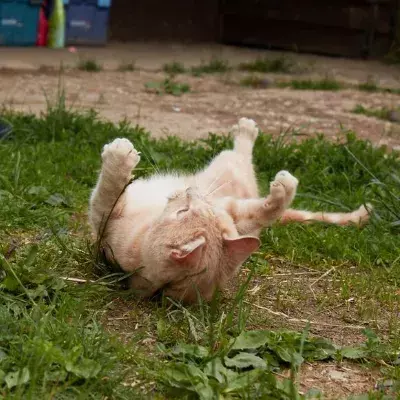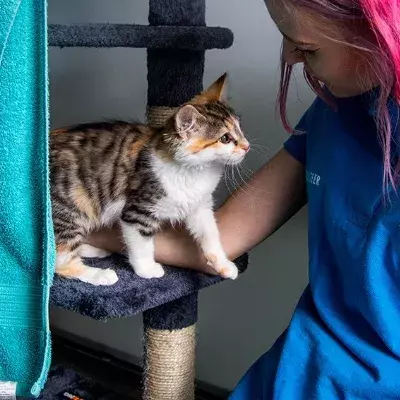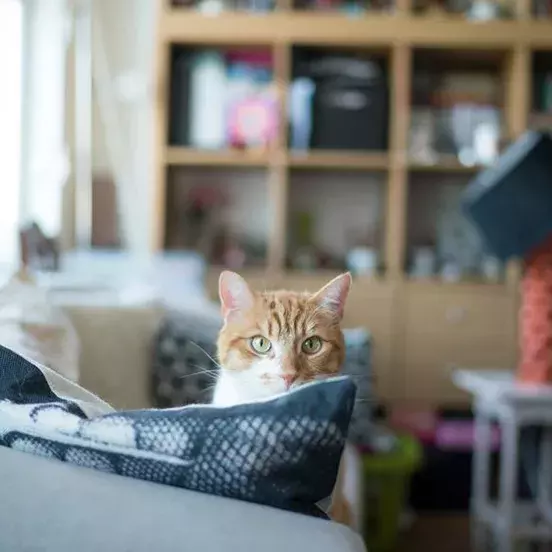The arrival of a new baby into the home is a very exciting time, but some cats may take a bit of time to adjust to a new arrival. Here we share some tips to help make the introduction of your baby and cat as smooth as possible.
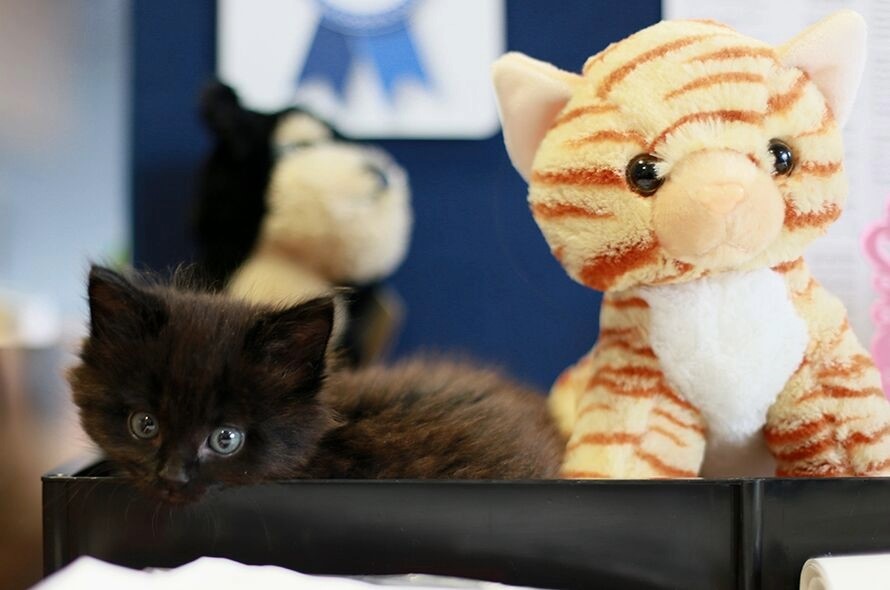
From your cat’s perspective the arrival of a baby can cause a lot of disruption, with new sounds and smells, changes in routine, the moving of furniture and the arrival of new objects such as toys, prams and cots. For some confident and inquisitive cats, the arrival of a new baby can be an interesting and intriguing time, but for other cats it can cause them stress and anxiety as they might not feel as ‘in control’ of their surroundings as usual.
Most cats tend to be creatures of habit and appreciate consistency and predictability. They are generally quite sensitive to noise, sudden changes in the environment, and certain types of handling that they aren’t used to. This means that it’s a good idea to gradually prepare your cat in advance of the new baby’s arrival, so that it is less of a ‘shock’ when the baby appears.
It’s also important to plan how you will manage a young child around your cat, particularly as they start to become more mobile and active.
TOP TIPS FOR GETTING CATS AND BABIES READY TO LIVE TOGETHER SAFELY
Your daily routine will probably change quite drastically when the baby arrives. If you can anticipate what is likely to change, and slowly introduce some of these changes in advance of the baby arriving, this may help your cat to feel less overwhelmed. Things that might change when your baby arrives include:
- The person who feeds the cat, where and at what times.
- The person who plays and interacts with the cat the most, at what times and how long for.
- The location of the cat’s food, water, litter trays, beds, scratching posts and toys.
- The parts of the house your cat will or won’t be able to access.
INTRODUCE NEW BABY ITEMS AND FURNITURE AHEAD OF TIME
Gradually introduce your cat to new objects associated with the baby (e.g. toys and prams) so that the cat will be familiar with them by the time the baby arrives. Each time you introduce a new object into the house, place it in a ‘neutral’ area (i.e. not directly near the cat’s food bowls or litter trays). Leave some of your cat’s favourite treats on or around the new item, and then let your cat explore it in their own time. Using a pheromone diffuser such as Feliway® around the house or spraying the new items with a few squirts from a bottle can also help your cat get used to the change in situation.
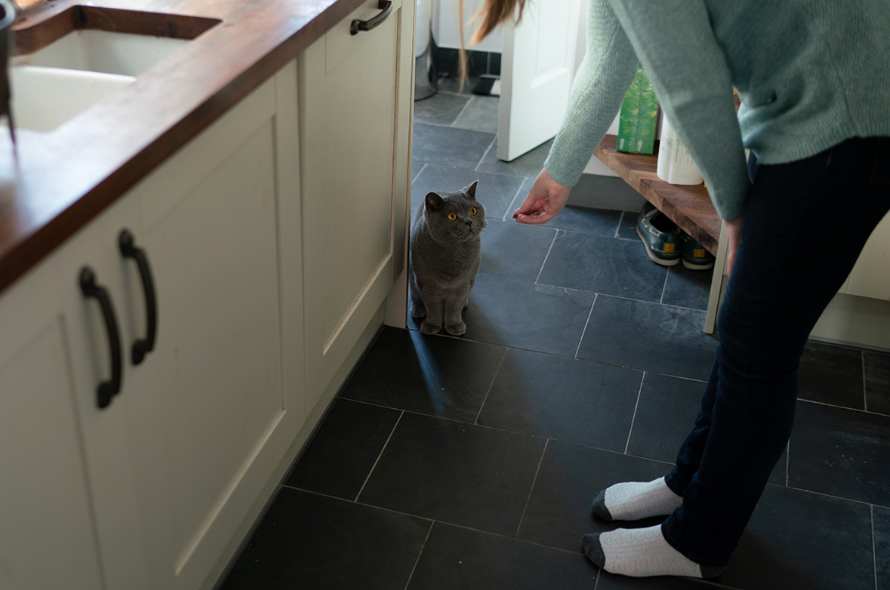
If there are items intended for the baby that you don’t want your cat to get used to sitting on or sleeping in (such as a crib or pushchair) then it is a good idea to place these out of reach of your cat or fill them with other items so that your cat cannot easily jump up into them.
INTRODUCE NEW BABY SOUNDS AND SMELLS AHEAD OF TIME
Before the baby arrives, you can also try playing recordings of the various sounds babies make (e.g. giggling, crying, calling and squealing) very quietly at first, and then gently increase the volume over time. This will give your cat time to gradually get used to these different noises before the baby arrives. Each time you play the recordings, you can also distract and reward your cat with a few treats.
Likewise, if mum and baby are likely to spend a few days in hospital before coming home, it may be a good idea to take a small item that has your baby’s smell on it, and place this somewhere in your home for your cat to sniff and investigate in their own time. This way your cat can start to familiarise itself with the baby before they actually meet.
GIVE YOUR CAT SPACE, IF THEY WANT IT
When you bring your baby home, let the cat decide whether they want to be near them or not. Don’t force them to meet in a confined space. Your cat may either want to investigate the child straight away or might be much more cautious and wary so let them go at their own pace. It’s best not to leave the baby and cat together unattended so that you can keep an eye on your cat’s behaviour.
For more information on reading your cat’s body language and understanding what emotions they may be experiencing, see Cat body language explained.
HOW CAN I TELL IF MY CAT IS, OR IS NOT, COPING WELL LIVING WITH CHILDREN AND BABIES?
If your cat is adjusting well to living with a child or baby, you should expect:
- No obvious changes to their normal routines
- The cat will eat, sleep, drink, groom and use their litter tray as normal
- The cat will seem relaxed and comfortable around the house, even around the child
If your cat is struggling to cope with being around children or babies, they may display a number of different behaviour or physical symptoms.
Behaviour symptoms
- Noticeable changes in their usual behaviour patterns.
- A reluctance to come into the house.
- Avoiding being in the house at certain times of day (for example in the mornings and afternoon/evening when children are more likely to be inside), or regularly avoiding certain parts of the house (such as the kitchen or children’s play areas).
- Frequent hiding when in the house (i.e. under the bed, on top of a wardrobe, under a chest of draws etc.).
- Frequent crouched or tense posture when in the house.
- Frequent rotation of the ears backwards or flattening of the ears downwards.
- Very dilated pupils and large round eyes.
- Going to the toilet outside of the litter tray (for example behind the sofa, under or on the bed).
- Spraying on furniture and other items around the house.
- Scratching furniture.
- Aggressive behaviour (for example hissing, growling, biting or scratching) directed towards humans or other animals in the house.
- Constantly trying to interact with you, if this is unusual for your cat.
- Or, if the cat is no longer interested in interacting with you, if this is unusual behaviour for them.
- Your cat no longer reacts to things going on around them.
- A fixed, downwards gaze towards the floor.
- Excessive meowing.
- Excessive grooming or rapid, frequent grooming that usually lasts around five seconds and starts and stops quite suddenly.
- Repeated pacing (or other repetitive behaviours) when in the house.
- Frequent head shaking.
- Rippling/twitching of the back.
- Vigorous swishing or thumping of the tail.
Physical symptoms
- Diarrhoea.
- Vomiting.
- Pica (eating of non-food items such as cat litter or string).
- Poor appetite and under eating.
- Lethargy and increased sleeping.
- Excessive eating and drinking.
- Weight loss or weight gain.
- A poor coat condition (e.g. a dull looking coat with dry skin).
- Large bald patches on the coat or sore or scabbed areas caused by over grooming.
- Stopping themselves going to the toilet.
- Cat flu.
- Cystitis.
- A weakened immune system, which may exacerbate other underlying conditions, or make them less resilient.
If you notice your cat displaying any of these symptoms it’s a good idea for you to seek help from your local vet or a cat behaviour counsellor.

